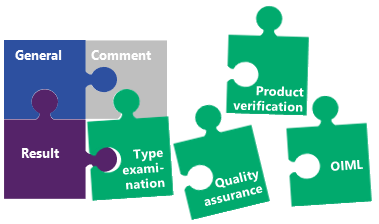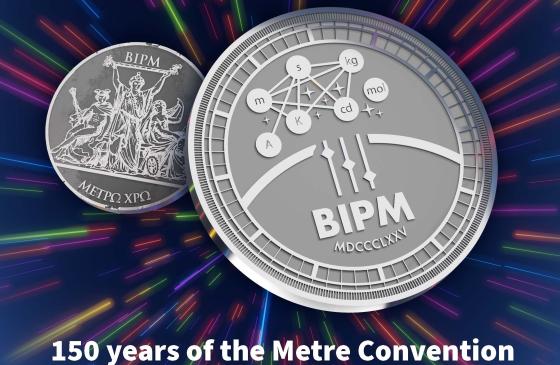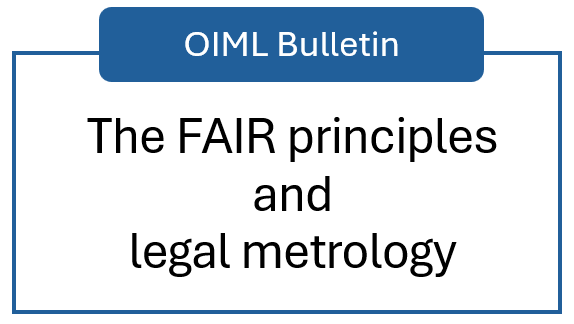OIML BULLETIN - VOLUME LXVI - NUMBER 3 - July 2025
e v o l u t i o n
Digital structures as enablers of FAIR data:
The example "Digital Certificate of Conformity"
Gisa Foyer and Tatyana Sheveleva
Citation: G. Foyer and T. Sheveleva 2025 OIML Bulletin LXVI(3) 20250305
Abstract
The "FAIR principles", widely discussed in the context of research data, are equally of interest in other areas. In this paper we discuss how the FAIR principles can be applied in legal metrology, and the importance of standardized data structures such as the “Digital Certificate of Conformity” (D-CoC).
The D-CoC data structure
The FAIR principles [1] originated in the context of research data. However, the FAIR principles can be applied to any type of data – including attestations, results, or certificates in the field of conformity assessment. In this article we discuss application of the FAIR principles to the "D-CoC" data structure for Digital Certificates of Conformity.
The D-CoC can be used to describe the content of any product certificate according to ISO/IEC 17065 [2] in combination with ISO/IEC 17067 [3] but was originally developed for certificates for measuring instruments in the European Union. The European Union has two legal acts ("Directives") for measuring instruments, both of which are part of a general product certification framework: the so-called New Legislative Framework, based on decision 768/2008/EU. They describe a modular certification system including modules such as type examination and product verification. Some of these modules require the involvement of a third-party conformity assessment body. As such bodies needs to be officially notified for specific modules and products, they are also referred to as notified bodies. They are certification bodies comparable to OIML-CS issuing authorities.
The coordination group "NoBoMet" (for Notified Bodies in Metrology) started a project group for digital certificates in 2021. Their first outcome was the data structure D-CoC [4] which describes the administrative information, including the issuing body, the manufacturer, and the object of the conformity assessment (e.g. type designation), as well as information on validity and dates. The published specification includes several elements, listed below.
A typical D-CoC element, e.g. “dcoc:manufacturer” [4], is represented by its designation (here as “manufacturer”) in combination with a namespace (dcoc). The two can be descriptive but could easily also be chosen randomly, e.g. xx:ab13. The meaning and use of the element is given by the combination of the label and the definition.
Each element is characterized as follows:
- Firstly, the data type of the element is specified. This may be a simple data type, such as string, boolean or date, or a more complex data type comprising multiple subelements. The element “dcoc:manufacturer” is of the complex data type “dcoc:contact”, which is also used for the description of certification body. The individual elements and complex data types can also contain attributes for additional information such as identifying elements and adding language information to strings, e.g. text information.
- Secondly, each element is given a cardinality consisting of two numbers. The first one gives the minimum number of occurrences, where 0 means the element is optional, and the second one gives the maximum number of occurrences. For example, the element “dcoc:manufacturer” has a cardinality of 1…1, meaning the data set must include the information about exactly one manufacturer. Other elements, such as “dcoc:previousCertificate”, have cardinality of 1…∞ and can be used several times.
- Thirdly, many elements include notes, restrictions or examples for better understandability.
In this way, the D-CoC [4] describes information about the entities involved, the product, the specification used, and so on. The following elements can be found at the top level of the specification:
- dcoc:certificationScheme
- dcoc:certificationBody
- dcoc:certNo
- dcoc:revision
- dcoc:modifications
- dcoc:manufacturer
- dcoc:categoryOfInstrument
- dcoc:certObjectIDs
- dcoc:certDate
- dcoc:certificationCriteria
- dcoc:additionallyAppliedDocuments
- dcoc:statement of conformity
- dcoc:validity
- dcoc:responsibles
- dcoc:previousCertificates
- dcoc:referenceNos
- dcoc:languages
The goal of this standardized data structure is to provide a common understanding of the information provided, which can be used in software implementations such as XML Schema or ontologies. The following section will illustrate why this is important when aiming for FAIR data.
Data structures in FAIR data
FAIR stands for Findable, Accessible, Interoperable and Reusable. As stated in the introduction, the main application of the FAIR principles is research data [1], but most of the principles also apply in the case of structured documents, such as type examination certificates.
The FAIR principles distinguish between data and metadata. To address these principles, it is therefore helpful to determine what constitutes data and what constitutes metadata. Considering type examinations in particular, there are data for the following topics:
- administrative data for the process of the certification – including information on the certification body as well as the certification scheme and certification criteria
- data on the process steps of the certification (testing, evaluation, and certification)
- data on the certified type of the instrument
- data for the certificate itself, such as number
This can be considered as the entire set of data. Normally, a subset is then used in databases or as main information for the certificate, namely the involved economic operators and bodies, type designation or validity dates. This is considered the metadata in the following. The elements of the D-CoC mostly describe the metadata.
Findable
To be findable, data has to have a globally unique and persistent identifier, it has to have metadata which includes this identifier, and everything has to be registered, or indexed. [1]
Information on certified measuring instruments also needs to be findable by market surveillance bodies, customers, or even manufacturers. This findability is normally managed within a certification system or scheme. In the OIML-CS, certificates can be found and uniquely identified in the OIML certificate database [5]. Often, a number of some kind with additional information on the revision is used as a certificate number. This applies in the OIML-CS as well as to other certification systems such as the Measuring Instruments Directive in the European Union. However, the content and the meta data of certificates are often not openly accessible, but need authorized access, e.g. for market surveillance. There are also differences as to whether certificates are registered centrally as, for example, in the OIML-CS, or at each certification body.
The D-CoC as a data structure provides two generally applicable elements “dcoc:certNo” and “dcoc:revision” for the identification of a certificate. These elements are only numbers or strings and are not described with unique identifiers such as UUID – but they serve the same purpose and are often sufficient, especially when combined with information on the certification body (“dcoc:certBody”) and the certification scheme (“dcoc:certificationScheme”, e.g. OIML-CS, Scheme A).
Accessible
Accessibility means that everyone should be able to retrieve the metadata, and under certain authorization conditions also the data itself. Furthermore, the metadata should remain available even after the data cease to exist. [1]
Type examination certificates are often only partially accessible to the public. In the OIML-CS, open access is possible via the database [5]. There is no machine-to-machine interface, but anyone can find and download the pdf version of certificates. In other certification systems, access to the database is restricted and often the technical annex to the certificate as well as further information are available only to authorized persons (e.g. market surveillance officers) upon request. Access rights depend very much on the certification system and its rules. In all cases, the information that a certificate has existed is kept in the respective databases as this is in general a requirement for certificates according to ISO/IEC 17065 to inform about the validity of each certificate [2].
It is not the task of a data structure like D-CoC to enable accessibility of data, but the responsibility of the “owner” of the certification system to define appropriate specifications.
Interoperable
To achieve interoperability [1], a description of the data and metadata is necessary. This has to be shared, based on machine-readable vocabularies, using a language that can be applied broadly.
Regarding type examination certificates, this requirement is not fulfilled on a machine-readable level, but rather on a human level by using templates, often as documents in text format, that ensure comparability between several documents. However, it is often not possible to ensure that the templates are used correctly, as can be seen in the OIML-CS certificate database, where several documents do not adhere to the template that is recommended. Nevertheless, the searchable metadata on the website is comparable.
To actually make information of type examination certificates comparable in a machine-readable format, a formal description is needed. as for example in a standardized data structure. This is the purpose of the D-CoC specification, which formally and accessibly describes how information should be structured, and even which parts of the information are mandatory or optional. There are other ways of communicating this information – for example with the use of ontologies – but a specification defining the structural elements is the minimum needed to fulfil the requirement of interoperability.
Reusable
To achieve reusability [1], well described data and metadata are requested together with clear data usage licensing and detailed provenance information as well as data meeting a community standard.
The objective of reusability is perhaps less important for type examination certificates, which should be available, understandable and comparable, but not reused in the same way as research data. Information on the manufacturer and the certification body is given, and together these constitute a minimum level of provenance information for the certificate. Furthermore, metadata are passed on in parts, for example for a declaration of conformity (e.g. in the European Union), or for use in other certificates (e.g. transfer from the OIML-CS to a national certification scheme). The last requirement on meeting community standards is partially met by certificate templates in text format. While these may not fulfil the strict requirements of the FAIR principles, they are generally the main objective of the D-CoC. In particular, the idea of defining the mandatory and optional elements of (meta)data ensures both interoperability and reusability. Therefore the D-CoC data structure improves the compatability with the FAIR principles for type examination certificates.

Summary and Outlook
The analysis of type examination certificates with respect to the FAIR principles has shown that several principles, such as findability or interoperability, are already fulfilled in part if the certificates are managed in databases with clear templates for the documents. A common data structure, such as the D-CoC, will be important for further development towards fulfillment of all the FAIR principles and the optimal use of (meta)data.
The next step in the development of the D-CoC within NoBoMet will be to provide specifications for the detailed technical data found in the annex of a type examination certificate, as well as for certificates for quality assurance and product verification, which are different conformity assessment modules in the European certification framework. The specifications will describe additional elements along the same lines as the first specification on the D-CoC. To maintain interoperability between the different documents, they will all be linked into the D-CoC structure in a modular way.
In the future, a similar specification will be developed for OIML-CS specific information. An extension of this system to other product groups, such as products in the area of explosive atmospheres, is also planned.
Acknowledgements
The work of all members of the NoBoMet project group “Digital certificates in metrology” is highly appreciated.
This research is part of the national project framework QI-Digital, funded by the German Federal Ministry of Economic Affairs and Energy.
References
[1] GO FAIR, “FAIR Principles.” Accessed: Jun. 12, 2025. [Online].
[2] ISO/IEC 17065:2012, Conformity assessment – Requirements for bodies certifying products, processes and services
[3] ISO/IEC 17067:2013, Conformity assessment – Fundamentals of product certification and guidelines for product certification schemes
[4] Documentation: Digital Certificate of Conformity (D-CoC). Document 1, 2023, European Coordination Group for Notified Bodies in Legal Metrology. Accessed: Jun. 12, 2025. Available online: https://circabc.europa.eu/webdav/CircaBC/nbg/NoBoMet%20(Notified%20Bodies%20in%20Legal%20Metrology)/Information/news_5ba7ba0a-bf8b-4421-8078-2f757d68a80b/NoBoMet_Documentation_D-CoC_V1.2.pdf
[5] OIML-CS Certificate database. Accessed: Jun. 12, 2025. Available online: https://www.oiml.org/en/oiml-cs/certificat_view






